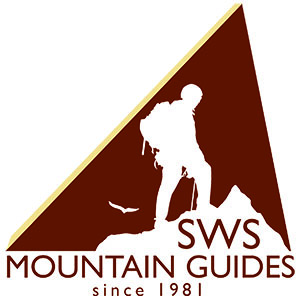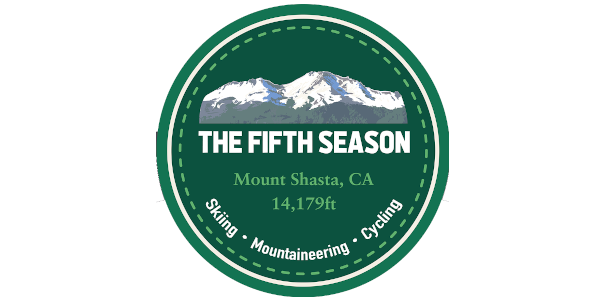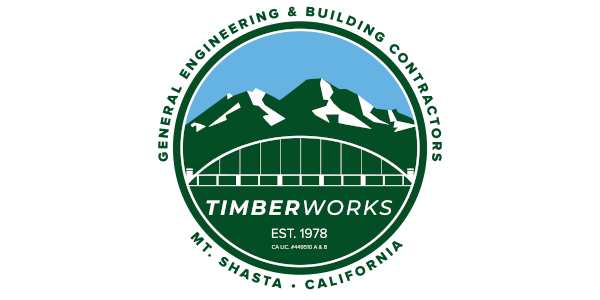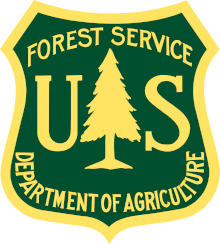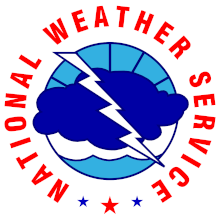Hello, and thank you for visiting! You have arrived at the best place on the internet for avalanche, climbing and weather information for Mt Shasta!
May continues to fly by with lots of sun and seasonable temperatures. Sunshine and warm temperatures through the last week have combined with good overnight refreeze to provide plenty of corn snow for all the ski/board mountaineers out there. Climbing and skiing/boarding conditions are at their best! That being said, the weather outlook for the weekend looks to be a little dodgy with some rain and snow expected. The mountain has all ready received a few inches of new snow near treeline overnight, and even more higher up. Wind transported snow will potentially form small wind slabs that may entrain enough snow to knock a person off of their feet, and even possibly bury them in the right set of circumstances. An avalanche beacon, shovel, and a probe are recommended equipment in addition to a mountain axe, helmet, and crampons. Avalanche danger is typically at its highest during and immediately after storm cycles. Good climbing conditions will last from now until at least late June to early July. Keep in mind that Mt Shasta is a 14,000 foot peak with potentially life threatening hazards if one does not prepare properly, so have the necessary skills, bring the right equipment, and know how to use it.
Mount Shasta City precipitation for the wet season (October through April) sits at 100% of normal and there is still about 6.5 feet of snow near treeline (7,600 feet) on the mountain. The weather for the climbing season thus far has been a mixed bag with warm temps and hot sun, some spring snow storms and rain, and even some occasional thunderstorms. For the remainder of the month we will continue to receive a variety of weather conditions that will change almost daily. It is common during the spring months for clouds to envelope the upper mountain limiting visibility. Climbers becoming disoriented on the upper mountain in white out conditions and subsequently descending the wrong route is not uncommon. These kinds of scenarios have resulted in many searches over the years. It should go without saying, but we will say it as a solid reminder: Check the weather before you go and more importantly, monitor the weather as you climb. DO NOT CLIMB INTO A WHITEOUT! Becoming caught on the mountain in any type of weather can compromise life and limb.
Currently, climbing conditions on the mountain are at their prime. One should expect winter like conditions at higher elevations requiring the appropriate gear and skill level. An ascent of the mountain on foot will involve a variety of snow conditions as current inclement weather will bring more snow and high winds over the coming days. Blowing dust from exposed ground, and tree pollen has started to collect making the snow near and below treeline a bit sticky in the afternoon hours. Overall you can expect some new snow on a firm old snow surface. Elevation and aspect will determine the type of snow you will find. In the morning, the snow is very smooth and very firm. Self arrest skills with your ice axe are a must. If you do not self arrest immediately during a fall you will surely take a big "slide for life" type of tumble.Stopping oneself after gaining speed as you slide is very difficult. The bottom line: practice using your ice axe for self arrest before you attempt to climb Mt Shasta in a low consequence area.
Rime ice fall has decreased, but will once again be a concern for those venturing to mid and upper mountain elevations after the coming storms. Rock outcroppings located at higher elevations will become covered with rime. Wind and the warming of the sun will cause the rime ice to peel off of rocks and tumble down slope creating a hazard to climbers. Rockfall is on the increase as well, and should be a concern while climbing. Wear a helmet, any time of year. Avalanche danger is typically at its highest during and immediately after storm cycles. Loose wet avalanches are also possible in the spring time. The Mt Shasta Avalanche Center has issued a Spring Statement hosting details on snow and avalanche conditions. Please read this on our avalanche advisory page.
Access to other trail heads is currently limited due to snow covered roads. Go to the "Climbing" tab and then click your trailhead of choice for a map of road access. Please note that the trailheads listed below are CLOSED. You may still access the mountain via these areas, but you'll need to get your summit pass, wilderness permit and pack-out bags at the ranger station or The Fifth Season in Mt Shasta.
Clear Creek TH- 0.5 miles of snow covered road to the trailhead.
Brewer Creek TH- 3.4 miles of snow covered road to the trailhead.
North Gate TH- road recieved 8-12 new inches Friday May 20th, limiting access to approximatley 1-2 miles from TH.
Please note that dogs are not allowed in the Mount Shasta Wilderness. Thank You.
The overall conditions and route descriptions change often. Check the weather and monitor our web site for weekly updates!
Our weather tab hosts numerous resources on weather. While the weather at lower elevations around Mt Shasta area can be decent, it's often that we'll get a cloud cap on Mt Shasta itself. We will say it again: Never climb into a white out as many climbers have become lost or died in similar conditions. Many routes from all aspects of Mt Shasta converge on the upper mountain (>12,500 feet). During limited visibility conditions, climbers have descended the wrong side of the mountain. Keep an eye to the sky as you climb, turning around if clouds begin to build on or near the mountain. Check the WEATHER FORECAST before coming up onto Mt Shasta!
Ice fall and rock fall are possible year round. It's a simple equation: as snow melts, rock fall increases. Further, if rime ice is seen plastered to exposed rocks above, it will eventually flake off and fall onto climbers at some point, guaranteed. Wear a helmet and keep your eyes up slope as you climb. Pay attention to other climbers: rock fall is often caused from climbers resting in melted out areas and accidentally dislodging rocks onto slopes/climbers below.
At a height of 14,179 feet Mount Shasta is a high altitude peak, and it is common for climbers to experience acute mountain sickness (AMS) with signs and symptoms of nausea, headache, and lightheadedness. Despite being a common condition, AMS should not be taken lightly. It can quickly develop into the much more serious, and potentially deadly pulmonary or cerebral edema. Stop and take a break. If symptoms do not improve, your only choice is to descend, descend, descend! SELF RESCUE IS HIGHLY RECOMMENDED should one become injured or sick.
The bottom line: BE PREPARED for full mountain conditions at any time. Do your research! ALWAYS WEAR A HELMET and KNOW HOW TO USE YOUR ICE AXE & CRAMPONS! Our goal is to ensure you have a positive wilderness experience and come home in one piece! Remember, YOU ARE RESPONSIBLE FOR YOUR OWN SAFETY.
YOU WILL NEED THE FOLLOWING MANDATORY ITEMS TO CLIMB MT SHASTA: **Wilderness Permit, Summit Pass, Human Waste Pack-out bags.
Wilderness Permits, Summit Passes, and Pack-out Bags are currently available at all trailheads and the Mt Shasta and McCloud Ranger Stations for self issue. Annual passes are only available at the ranger stations and at The Fifth Season in Mt Shasta. The Mt Shasta Ranger Station is open Monday through Friday from 8 to 4:30pm. The McCloud station is open 8-4:30, Monday through Friday. Check our 'climbing regulations' section for more details.
HORSE CAMP: The bathrooms are OPEN at Horse Camp and WATER is available. One must melt snow for water elsewhere, so bring extra fuel. The Horse Camp cabin and the surrounding property are owned and managed by the Sierra Club Foundation. The cabin is open year round and all are welcome, however one cannot sleep inside the cabin except in emergencies. Make sure you close the door when you leave. If you plan on camping at Horse Camp, please make sure to pitch your tent on either an existing tent site or on snow. Please DO NOT camp anywhere snow has melted, near tree wells, or where a tent site is not obvious. There is a caretaker on duty currently. A nominal $3 bivy/$5 tent fee is asked if camping at Horse Camp. Lastly, the Sierra Club Foundation manages their property under the Mt Shasta Wilderness rules - that means dogs are not allowed on their property either. Please respect the rules... Thanks!
TIPS and NOTES: Climb early and descend early. This limits exposure to inclement weather (afternoon buildup of clouds is common), allows plenty of time to descend before dark, and also allows a rescue effort to ensue before dark in the event one gets injured or lost.
Avalanche training along with a transceiver, shovel and probe are recommended in winter and spring.
Get an alpine start (2-5am) and have a turn around time of 12 to 1pm. Proper equipment, clothing and training are a must. Helmets are recommended always and expect rock and ice fall at all times.
Mt Shasta is a 14,000 foot lightening rod and is frequently hit by lightning (usually in summer and fall months), so don't push your luck with building thunderheads.
Do not expect to be rescued. Rather, prevent rescues from happening in the first place, and be prepared to handle rescues within your own climbing party should something happen. Nature sets its own terms and YOU must judge how much risk you are willing to accept. Extra warm gear (like a down jacket, balaclava and extra gloves) are a good idea in winter, spring and fall as climbers often develop superficial frost bite during strong winds. The wind chill temperature near the summit in winter and spring can be well below zero. Anchor your tent well wherever you camp. Tents can and do blow away frequently. Do not plan to camp above treeline if you do not have anchor lines for your tent.
The best time to climb Mt Shasta is generally from late May to mid July on the south and west sides of the mountain when summer days are longer and the weather is generally stable. However in dry years, the thin snow pack creates the best climbing conditions in April, May and early June. When the snow melts, you are left with 7,000 feet of scree, talus and boulders. In heavy snow years the climbing season extends to August or September. There is NO trail to the summit. Climbing is much more safe and fun on consolidated snow. The routes on the north and east sides are not recommended for un-guided novices; glacier travel and route finding skills are prerequisites. Spring and summer can bring the chance of thunderstorms. The TEN essentials keep you and your party out of search and rescue statistics by using common sense and carrying the following: map, compass, sunglasses and sunscreen, extra food and water, extra clothing, head lamp/flashlight, first aid kit, matches/lighter, stove, knife/multi-tool and a bivy sack. If you choose to climb: Solo climbing is not recommended. Traveling with an experienced grouped is a good idea, and remember - do not split up the group! Wear a helmet, know how to use your equipment and use common sense and carry the ten essentials. The mountain has extreme weather changes. Be prepared, pay attention!
A note on wind... Mount Shasta stands by itself in the atmosphere. There is nothing anywhere near its height for over a hundred miles. Because of that, Mt Shasta creates a lot of unique wind conditions. Especially during the winter, spring and early summer, the snow covered mountain provides very little friction for accelerating winds bending around and over this topographic anomaly. Winds over 100 mph at tree line (8,000 ft) are common. It's anyone's guess what the winds at 14,000 feet could be when instruments measure 150 mph wind speeds at lower elevations on the mountain. Winds of 40 mph can knock you off balance. Winds of 60-70 mph can force you to crawl (and cry!). Hurricane strength winds (>74 mph) can make it nearly impossible to stand and destroy well anchored tents. The strongest winds occur with big pressure and temperature gradients in the atmosphere and tend to occur in front of, and behind storms. The lowest winds occur when the center of a high pressure is over the Mt Shasta area. Take this seriously as wind has resulted in searches, injuries and fatalities.
Reminder: DOGS ARE NOT ALLOWED IN THE MT. SHASTA WILDERNESS
THANK YOU and see you on the mountain!
The Mt Shasta Climbing Rangers
Nick, Jon, Forrest, and Matt














